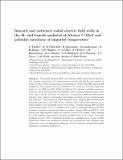Inboard and outboard radial electric field wells in the H- and I-mode pedestal of Alcator C-Mod and poloidal variations of impurity temperature
Author(s)
Landreman, Matthew Joseph; Parra, F.I.; Theiler, Christian; Lipschultz, Bruce; Ernst, Darin R.; Hughes, Jerry W., Jr.; Catto, Peter J.; Hutchinson, Ian H.; Reinke, Matthew Logan; Hubbard, Amanda E.; Marmar, Earl S.; Churchill, Randy Michael; Terry, J. T.; Walk, John R.; ... Show more Show less
DownloadHutch Theiler_submitted.pdf (1008.Kb)
OPEN_ACCESS_POLICY
Open Access Policy
Creative Commons Attribution-Noncommercial-Share Alike
Terms of use
Metadata
Show full item recordAbstract
We present inboard (HFS) and outboard (LFS) radial electric field (E[subscript r]) and impurity temperature (T[subscript z]) measurements in the I-mode and H-mode pedestal of Alcator C-Mod. These measurements reveal strong Er wells at the HFS and the LFS midplane in both regimes and clear pedestals in T[subscript z], which are of similar shape and height for the HFS and LFS. While the H-mode E[subscript r] well has a radially symmetric structure, the E[subscript r] well in I-mode is asymmetric, with a stronger ExB shear layer at the outer edge of the E[subscript r] well, near the separatrix. Comparison of HFS and LFS profiles indicates that impurity temperature and plasma potential are not simultaneously flux functions. Uncertainties in radial alignment after mapping HFS measurements along flux surfaces to the LFS do not, however, allow direct determination as to which quantity varies poloidally and to what extent. Radially aligning HFS and LFS measurements based on the T[subscript z] profiles would result in substantial inboard-outboard variations of plasma potential and electron density. Aligning HFS and LFS E[subscript r] wells instead also approximately aligns the impurity poloidal flow profiles, while resulting in a LFS impurity temperature exceeding the HFS values in the region of steepest gradients by up to 70%. Considerations based on a simplified form of total parallel momentum balance and estimates of parallel and perpendicular heat transport time scales seem to favor an approximate alignment of the E[subscript r] wells and a substantial poloidal asymmetry in impurity temperature.
Date issued
2014-06Department
Massachusetts Institute of Technology. Department of Physics; Massachusetts Institute of Technology. Plasma Science and Fusion CenterJournal
Nuclear Fusion
Publisher
IOP Publishing
Citation
Theiler, C., R.M. Churchill, B. Lipschultz, M. Landreman, D.R. Ernst, J.W. Hughes, P.J. Catto, et al. “Inboard and Outboard Radial Electric Field Wells in the H- and I-Mode Pedestal of Alcator C-Mod and Poloidal Variations of Impurity Temperature.” Nuclear Fusion 54, no. 8 (June 18, 2014): 083017.
Version: Author's final manuscript
ISSN
0029-5515
1741-4326